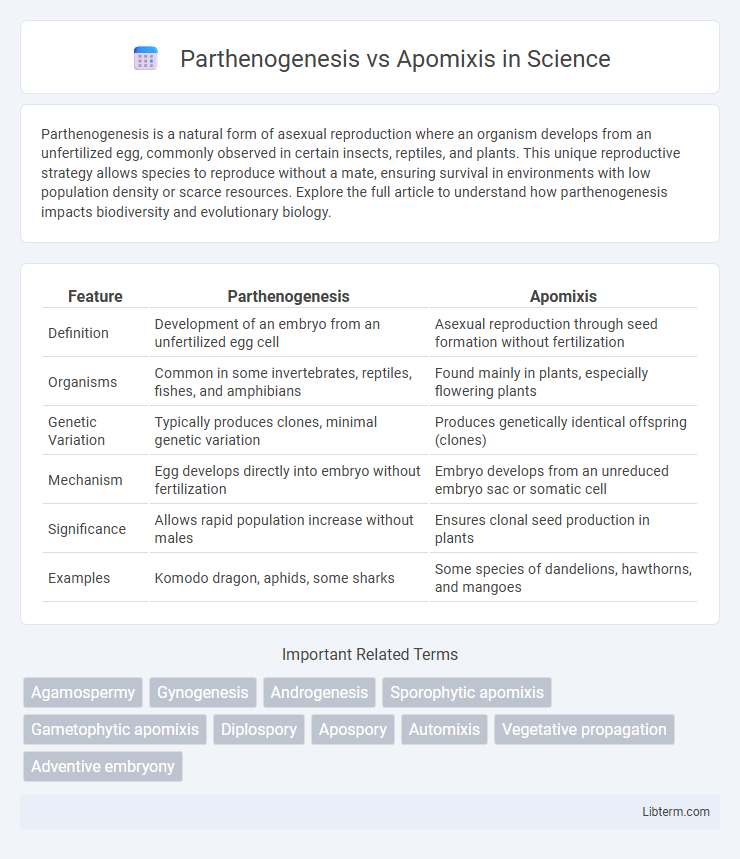Parthenogenesis is a natural form of asexual reproduction where an organism develops from an unfertilized egg, commonly observed in certain insects, reptiles, and plants. This unique reproductive strategy allows species to reproduce without a mate, ensuring survival in environments with low population density or scarce resources. Explore the full article to understand how parthenogenesis impacts biodiversity and evolutionary biology.
Table of Comparison
| Feature | Parthenogenesis | Apomixis |
|---|---|---|
| Definition | Development of an embryo from an unfertilized egg cell | Asexual reproduction through seed formation without fertilization |
| Organisms | Common in some invertebrates, reptiles, fishes, and amphibians | Found mainly in plants, especially flowering plants |
| Genetic Variation | Typically produces clones, minimal genetic variation | Produces genetically identical offspring (clones) |
| Mechanism | Egg develops directly into embryo without fertilization | Embryo develops from an unreduced embryo sac or somatic cell |
| Significance | Allows rapid population increase without males | Ensures clonal seed production in plants |
| Examples | Komodo dragon, aphids, some sharks | Some species of dandelions, hawthorns, and mangoes |
Introduction to Parthenogenesis and Apomixis
Parthenogenesis is a form of asexual reproduction where offspring develop from an unfertilized egg, commonly found in certain insects, reptiles, and plants. Apomixis is a type of asexual reproduction in plants where seeds are produced without fertilization, enabling clonal propagation of genetically identical offspring. Both mechanisms bypass the genetic recombination process typical of sexual reproduction, allowing rapid population expansion under stable environmental conditions.
Defining Parthenogenesis: Mechanisms and Occurrence
Parthenogenesis is a form of asexual reproduction where an embryo develops from an unfertilized egg, bypassing the typical fusion of gametes. This mechanism occurs in various species including certain insects, reptiles, and fish, showcasing diverse cellular processes such as automixis and apomixis that maintain genetic stability or introduce variation. Parthenogenetic reproduction enables rapid population increase and survival in environments where mates are scarce.
Understanding Apomixis: Types and Processes
Apomixis is a form of asexual reproduction in plants where seeds develop without fertilization, ensuring genetic uniformity across generations. It includes mechanisms such as gametophytic apomixis, involving the formation of an unreduced embryo sac, and sporophytic apomixis, where embryos arise directly from somatic cells of the ovule. Understanding these processes is crucial for advancements in agriculture, as apomixis enables the propagation of hybrid vigor without genetic segregation.
Key Differences Between Parthenogenesis and Apomixis
Parthenogenesis is a form of asexual reproduction where an embryo develops from an unfertilized egg cell, occurring mainly in animals like certain insects and reptiles. Apomixis refers to asexual reproduction in plants, specifically seed formation without fertilization, commonly observed in species such as dandelions and citrus. The key difference lies in parthenogenesis producing offspring genetically identical to the mother via egg development, whereas apomixis involves seed production bypassing meiosis and fertilization, ensuring clonal propagation of the maternal genotype.
Evolutionary Significance of Asexual Reproduction
Parthenogenesis and apomixis represent asexual reproductive strategies offering evolutionary advantages by enabling rapid population growth without genetic recombination, preserving advantageous gene combinations. Parthenogenesis occurs primarily in animals, producing offspring from unfertilized eggs, while apomixis occurs in plants, leading to clonal seed production. Both methods facilitate survival in stable environments but limit genetic diversity, potentially reducing adaptability to environmental changes.
Genetic Implications: Variation and Stability
Parthenogenesis results in offspring that are typically clones of the mother, reducing genetic variation and enhancing genetic stability within a population. Apomixis, a form of asexual reproduction through seeds, similarly produces genetically identical progeny, maintaining genetic uniformity over generations. Both processes limit genetic diversity, which can impact adaptability but ensure stable transmission of successful genotypes.
Parthenogenesis in Animals: Notable Examples
Parthenogenesis in animals is a form of asexual reproduction where offspring develop from unfertilized eggs, observed notably in species such as the Komodo dragon, certain sharks like the bonnethead, and some insect groups including aphids. This process allows for rapid population growth and survival in environments with scarce mates. Unlike apomixis, which occurs primarily in plants and involves seed formation without fertilization, parthenogenesis enables animal species to reproduce clonally without genetic variation introduced by sexual reproduction.
Apomixis in Plants: Major Case Studies
Apomixis in plants refers to a form of asexual reproduction where seeds develop without fertilization, enabling clonal propagation of the maternal genotype. Prominent case studies include Taraxacum (dandelion), Hieracium (hawkweed), and Paspalum, where apomixis confers ecological advantages like rapid colonization and stability of hybrid vigor. Research on apomictic species provides insights into harnessing apomixis for crop improvement by fixing desirable traits and reducing dependency on hybrid seed production.
Ecological and Agricultural Impact
Parthenogenesis enables rapid population growth in certain animal species by producing offspring from unfertilized eggs, which can lead to ecological imbalances through reduced genetic diversity. Apomixis, a form of asexual seed production in plants, offers significant agricultural benefits by allowing the propagation of hybrid crops with stable desirable traits across generations, enhancing crop yield and resilience. Both processes reduce genetic variability, impacting ecosystem adaptability and necessitating careful management to maintain biodiversity and sustainable agricultural practices.
Future Research and Applications
Future research on parthenogenesis and apomixis aims to unlock genetic mechanisms enabling clonal seed production, potentially revolutionizing crop breeding by fixing hybrid vigor across generations. Advances in gene editing technologies such as CRISPR-Cas9 facilitate targeted manipulation of reproductive pathways, accelerating development of high-yield, stress-resistant plant varieties without sexual reproduction. Applications include sustainable agriculture through uniform, disease-resistant cultivars, reduced dependency on chemical inputs, and enhanced food security amid climate change challenges.
Parthenogenesis Infographic

 libterm.com
libterm.com